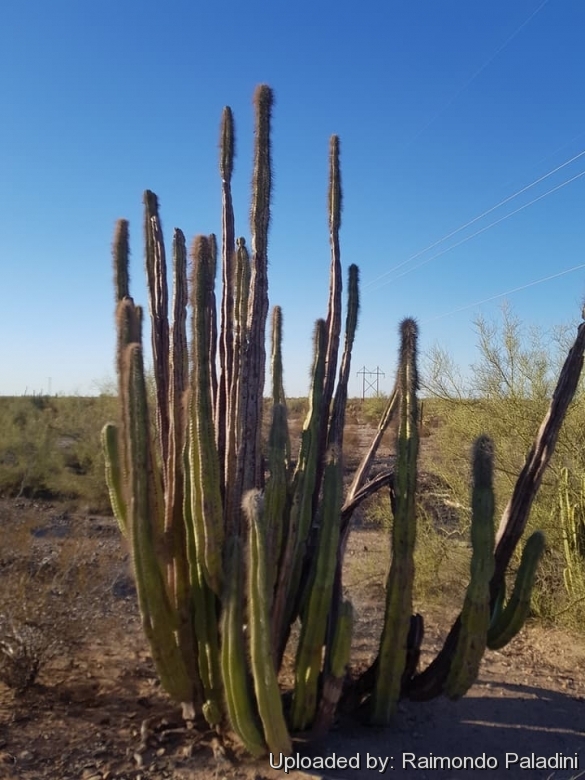
Pachycereus schottii Photo by: Raimondo Paladini
In habitat, Mexico.
Origin and Habitat: Lophocereus schottiiSN|8344]]SN|8344]] is native to the desert regions of mainland Mexico in the states of Baja California, Baja California Sur, Sinaloa and Sonora. Small populations also occur in the extreme south of Arizona. The monstrous form is restricted to a small area NE of El Arco, about halfway down the Baja peninsula.
Altitude range: It grows from sea level to 800 m asl.
Habitat: It tends to grow in colonies in favourable locations in dunes, stream shores, thin soil and on rocky hillsides. It grows mainly on alluvial plains in dry gravely soils and in desert riparian environments, but its northern limit in southern California can get frosts that can occur on the flat sites where it grows. Here plants are smaller in size than their more southerly counterparts. Reproduction in this part of its range is predominantly asexual and occurs either by the dispersal of stems in the immediate vicinity of parents, or by the long-distance transport of detached stem pieces downstream by floodwaters. Wild plants are heavily weathered and badly marked with just the newest growing tips in good condition. In Arizona and Sonora it occurs in desert scrub. The northern distribution is limited by freezing temperatures The species is abundant, in some places exceedingly so, and widely distributed. The population is generally stable, although perhaps declining on the continent (not on islands or peninsula). Land transformation for agriculture (mainly on the continent, and parts of the peninsula), and resort development along the coast are the main threats affecting this cactus.
Ecology: Lophocereus schottiiSN|8344]]SN|8344]] schottii has recently been found to have an obligate mutualistic association with a pyralid moth, Upiga virescens, which pollinates the small flowers and lays its eggs in them so that the larvae can develop by feeding on the fruit tissues. Females of this moth collect pollen on specialized abdominal scales and actively deposit pollen on the stigmas of sinita flowers. As much as 90% of the fruit set may be due to these moths. Patrolling ants attracted to extrafioral nectaries in the ar-eoles may provide protection from herbivorous insects. Birds and ants remove the pulp and seeds, leaving only the hollowed fruit case.
Synonyms:
See all synonyms of Pachycereus schottii
Common Names include:
ENGLISH: Old man cactus, Senita cactus, Totem cactus (A cultivated monstrose form), Whisker Cactus
MAYO (Mayo): Musue
ÓPATA (Tegüima): Temi
O\'ODHAM or PAPAGO-PIMA (O\'odham ñiok): Ce:mĭ
SERI (Cmiique iitom): Hasahcápöj
SPANISH (Español): Cabeza vieja, Hombre viejo, Pitaya barbona, Cinita, Senita, Cina, Garambullo, Mochi, Sina, Sinita, Tuna barbona, Viejo
YAQUI (Yoem Noki): Museo
Description: Lophocereus schottiiSN|8344]]SN|8344]] is a slow-growing usually trunkless cactus that forms numerous tall, ascending, columnar stems which branch mostly at or near the base in a candelabra-like arrangement.
Stems: Usually 2-4 metres tall (but can grow up to 7 m high), 8 to 16 cm in diameter, mostly erect and slightly tapering toward the upper part reproductive part which do not exceeds 5-10 cm in diameter, grey-green with a waxy bloom on the surface. A distinctive characteristic of this species is that the cut stem surfaces quickly turn black.
Ribs: Ribs in juvenile and young stems are fewer 5-6(rarely 7) and widely-spaced, ribs in the upper thinner (fertile) portion of the stem increase in number to 6-8. Occasionally the ends of stems will spiral a little or dramatically in a right or left hand manner Such top cuttings are much prized by enthusiasts, fetching high prices.
Areoles: In the bottom part of the stems are oval and bears white wool.
Spines: One of the most distinguishing features is that the tips of the mature (fertile), taller stems are covered with about twenty sharp long, hairlike, strongly twisted grey bristles often 4-10 cm long. In contrast to the long spines at the tips of mature stems, the juvenile plants have only about five short conical spines as short as 5-7 mm, thick, rigid, not twisted.
Flowers: This species blooms in the apical 'hairy' part of the stems. Flowers are nocturnal, open at dusk and continue until early morning when the sun burns them out, but on cool days (e.g.. in March) sometimes remaining open part of the day. They are 3-5 cm long, 4-4.5 cm wide greenish white on the underside and pinkish white inside, and emit an unpleasant odour.
Blooming season: One or several flowers are produced from each areole during most of the year, mainly from (March-)April to September(-December).
Fruits: The edible fruits are rounded, mostly 2.3-4.0 cm in diameter, as red as ripe strawberries (with a red pulp), spineless or nearly so and are seldom seen. Fruiting April-December. the peak often in June when the upper stems may be loaded with fruits.
Seeds: Blackish. 2.2-2.8 mm in diameter, shiny, and smooth.
Subspecies, varieties, forms and cultivars of plants belonging to the Pachycereus schottii group
 Pachycereus schottii (Engelm.) D.R.Hunt: (var. schottii ) has relatively thick stems with fewer (5-6) stem ribs, and and trunk-less habit with numerous, ascending, columnar stems in a candelabra-like arrangement. Distribution: northern part of the range (southwestern Arizona to the Guaymas region and inland to Hermosillo, also Baja California to northern Baja California Sur.)
Pachycereus schottii (Engelm.) D.R.Hunt: (var. schottii ) has relatively thick stems with fewer (5-6) stem ribs, and and trunk-less habit with numerous, ascending, columnar stems in a candelabra-like arrangement. Distribution: northern part of the range (southwestern Arizona to the Guaymas region and inland to Hermosillo, also Baja California to northern Baja California Sur.)  Pachycereus schottii f. cristatus: This is a highly priced crested form for its sculptural shape. There are indeed other crested clones that have a tendency to fan out, some will form stable crests while others just cluster over one another.
Pachycereus schottii f. cristatus: This is a highly priced crested form for its sculptural shape. There are indeed other crested clones that have a tendency to fan out, some will form stable crests while others just cluster over one another. Pachycereus schottii f. mieckleyanus (Weing.) P.V.Heath: This monstros form has thinner stems with less tubercles. Stems are ascending but not straight with irregular bumps, slim, lightly pruinose, and also branch just from the base and occasionally at higher levels
Pachycereus schottii f. mieckleyanus (Weing.) P.V.Heath: This monstros form has thinner stems with less tubercles. Stems are ascending but not straight with irregular bumps, slim, lightly pruinose, and also branch just from the base and occasionally at higher levels Pachycereus schottii f. monstrosus (H.E.Gates) P.V.Heath: Mutation with variable, irregularly shaped ribs with raised, tubercle-like, knobby-looking swellings along the stems, and few (if any) spines or bristles.
Pachycereus schottii f. monstrosus (H.E.Gates) P.V.Heath: Mutation with variable, irregularly shaped ribs with raised, tubercle-like, knobby-looking swellings along the stems, and few (if any) spines or bristles.- Pachycereus schottii var. tenuis (G.E.Linds.) P.V.Heath: usually forms a short trunk, has more slender stems with 6-10 ribs, and is shrub sized. Distribution: Sonora, northwestern Sinaloa, and Baja California Sur.
 Pachycereus schottii cv. Big Penis Cactus: is a controversial monstrous cactus species with smooth rib-less stems, dubiously thought of as a mutant Lophocereus schottii and remembering of a large-sized Echinopsis bridgesii f. monstruosa (Long joined type).
Pachycereus schottii cv. Big Penis Cactus: is a controversial monstrous cactus species with smooth rib-less stems, dubiously thought of as a mutant Lophocereus schottii and remembering of a large-sized Echinopsis bridgesii f. monstruosa (Long joined type).
Bibliography: Major references and further lectures
1) Forest & Kim Starr “Pachycereus schottii (Senita cactus, whisker cactus).” Plants of Hawaii. <http://www.starrenvironmental.com>. Downloaded on 20 August 2014.
2) James Cullen, Sabina G. Knees, H. Suzanne Cubey “The European Garden Flora Flowering Plants: A Manual for the Identification of Plants Cultivated in Europe, Both Out-of-Doors and Under Glass” Cambridge University Press, 11/Aug/2011
3) Curt Backeberg “Die Cactaceae: Handbuch der Kakteenkunde” Vol. 4 G. Fischer, 1960
4) Hans Hecht “BLV-Handbuch der Kakteen” BLV, 1991
5) David Hunt, Nigel Taylor “The New Cactus Lexicon” DH Books, 2006
6) Erik Haustein “Der Kosmos-Kakteenführer: Bestimmung, Pflege, Vermehrung. Über 490 Kakteenarte” Franckh-Kosmos, 1998
7) Sara Oldfield “Cactus and succulent plants: status survey and conservation action plan” IUCN, 1997
8) Edward F. Anderson “The Cactus Family” Timber Press, 2001
9) Theodore H. Fleming, Alfonso Valiente Banuet “Columnar Cacti and Their Mutualists: Evolution, Ecology, and Conservation” University of Arizona Press, 2002
10) Britton & Rose "The Cactaceae" 4: 273, 1923
11) Burquez Montijo, A. 2013. Pachycereus schottii. The IUCN Red List of Threatened Species. Version 2014.2. <www.iucnredlist.org>. Downloaded on 24 September 2014.
12) Tucson Richard Stephen Felger Executive Director Drylands Institute, AZ, University of Arizona Matthew Brian Johnson Program Manager and Curator Desert Legume Program, Tucson Michael Francis Wilson Research Director Drylands Institute, AZ "The Trees of Sonora, Mexico" Oxford University Press, 31/Mar/2001
13) Peter Hanelt, Institute of Plant Genetics and Crop Plant Research, W. Kilian "Mansfeld's Encyclopedia of Agricultural and Horticultural Crops: (Except Ornamentals)" Springer Science & Business Media, 10/Apr/2001
14) Richard Stephen Felger "Flora of the Gran Desierto and Rio Colorado of Northwestern Mexico" University of Arizona Press, 2000
15) Park S. Nobel "Cacti: Biology and Uses" University of California Press, 2002
16) Theodore H. Fleming, Alfonso Valiente-Banuet "Columnar Cacti and Their Mutualists: Evolution, Ecology, and Conservation Copertina anteriore" University of Arizona Press, 2002
17) Wendy C. Hodgson "Food Plants of the Sonoran Desert" University of Arizona Press, 2001
18) Richard S Felger, Benjamin Theodore Wilder, Humberto Romero-Morales "Plant Life of a Desert Archipelago: Flora of the Sonoran Islands in the Gulf of California" University of Arizona Press, 31/Jan/2013
 Pachycereus schottii Photo by: Valentino Vallicelli
Pachycereus schottii Photo by: Valentino Vallicelli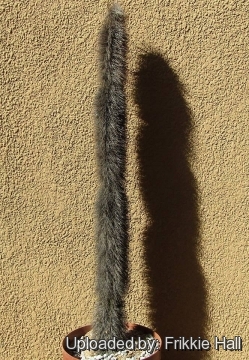 - This is a side arm of the normal form of Lophocereus schottii. The plant starts off with clean branches, but when it is mature to flower, it starts to produce spines. It does not make a cephalium, it just flowers normal. All the spines are downward pointing, so possibly do this to prevent rodents to eat the fruit, but rather have it distributed by birds over greater distances. Photo by: Frikkie Hall
- This is a side arm of the normal form of Lophocereus schottii. The plant starts off with clean branches, but when it is mature to flower, it starts to produce spines. It does not make a cephalium, it just flowers normal. All the spines are downward pointing, so possibly do this to prevent rodents to eat the fruit, but rather have it distributed by birds over greater distances. Photo by: Frikkie Hall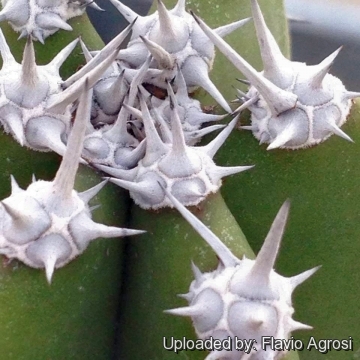 Juvenile spines Photo by: Flavio Agrosi
Juvenile spines Photo by: Flavio Agrosi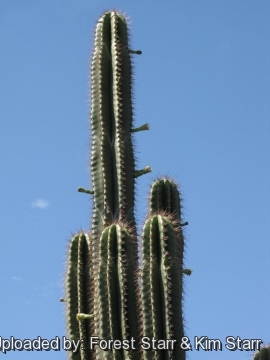 Pachycereus schottii Photo by: Forest Starr & Kim Starr
Pachycereus schottii Photo by: Forest Starr & Kim Starr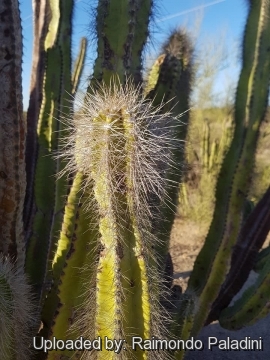 Lophocereus schottii, cephalium. Photo by: Raimondo Paladini
Lophocereus schottii, cephalium. Photo by: Raimondo Paladini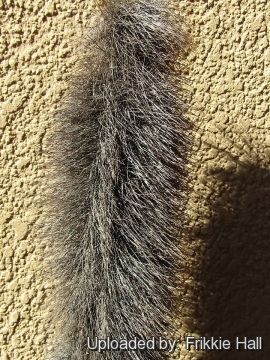 Lophocereus schottii. Flowering branch. Photo by: Frikkie Hall
Lophocereus schottii. Flowering branch. Photo by: Frikkie Hall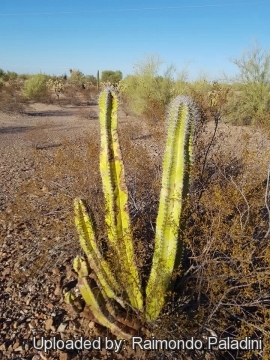 Lophocereus schottii, juvenile specimen. Photo by: Raimondo Paladini
Lophocereus schottii, juvenile specimen. Photo by: Raimondo Paladini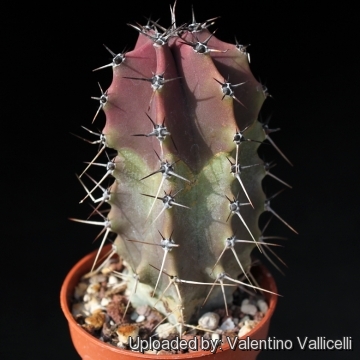 Pachycereus schottii Photo by: Valentino Vallicelli
Pachycereus schottii Photo by: Valentino VallicelliCultivation and Propagation: This species presents no problems in cultivation and will do well in a sunny spot in a cactus house. These plants will tolerate extreme sun and heat, but not extended periods of frost. They can survive to a minimum temperature of -9°C (for Arizona clones), but the growing tips need protection. They will tolerate severe drought if they have a large colony of stems. Grow them in rich, porous, sandy soil, and let their soil dry out between waterings. If potted, repot in the spring, if their roots become cramped. Generally, they should be repotted every other year in order to provide fresh soil. However, this doesn't necessarily mean they'll need larger containers. Fill about a quarter of the pot with broken crocks, gravel, etc. to promote good drainage. After repotting, do not water for a week or more. It enjoy a warm sunny environment and for more speedy growth a light position on a higher shelf with light feeding and rainwater given to the bottom of the plant will ensure success, especially with rooted detached branches, which do well in these conditions. Often plants can be seen with a root or two projecting from a lower stem. Plants in cultivation will begin to get a bit tatty after several years, and if you wrap an offset in newspaper and send it to your friend through the post, it will probably get marked anyway.
Food uses: Seeds and pulp are edible. Pulp is red and sweet but not as delicious as that of organpipe (Stenocereus thurberiSN|8265]]SN|8265]]) or sahuaro (Carnegiea giganteaSN|6374]]SN|6374]]). The seeds are eaten slightly browned or made into flour.
Medical uses: Considerable quantifies of stems are harvested in northern Sonora and sold in marketplaces and herbal shops from Tijuana to Mexico City. The five-ribbed stems are highly esteemed and much used as remedies for diabetes, stomach ulcers, cancer, poor blood circulation, and hair loss. (The five-ribbed stems are thicker and more mucilaginous than t he fertile or upper stems.) Stem cross-sections are boiled and the liquid drunk throughout the day in place of drinking water. The species contains steroids which can be applied like hormones for humans and other mammals.
Propagation: It can be increased by seeds or cuttings, which will take root in a minimum temperature of 20° C. Cuttings of healthy shoots can be taken in the spring and summer. Cut the stem with a sharp, sterile knife just above a bud or shoot (a 7-10cm long tip or branch is most suitable for propagation). Leave the cutting in a warm, dry place for a week or weeks (depending on how thick the cutting is) until a callus forms over the wound. Once the callus forms, the cutting may be inserted in a container filled with firmed cactus potting mix topped with a surface layer of coarse grit. They should be placed in the coarse grit only; this prevents the cut end from becoming too wet and allows the roots to penetrate the rich compost underneath. The cuttings should root in 2 to 6 weeks.
Your Photos

by Raimondo Paladini

by Forest Starr & Kim Starr

by Valentino Vallicelli





















